What Types of Greenspaces Are Associated with Depression in Urban and Rural Older Adults? A Multilevel Cross-Sectional Study from JAGES
Abstract
1. Introduction
2. Materials and Methods
2.1. Selection and Description
2.1.1. Description of the Setting
2.1.2. Selection and Description of the Setting
2.2. Outcome Variables
2.3. Types of Greenspace
2.4. Individual-Level Covariates
2.5. Neighborhood-Level Covariates
2.6. Statical Analysis
3. Results
3.1. Participants’ Characteristics
3.2. Results of the Neighborhood Level Correlation Analysis
3.3. Results of the Pre-Stratification Analysis
3.4. Results of the Urban Area Analysis
3.5. Results of the Rural Area Analysis
4. Discussion
4.1. Results from the Urban Stratified Analysis
4.2. Results from the Rural Stratified Analysis
4.3. Features of the Analysis Method Used in This Study
4.4. Limitations
5. Conclusions
Author Contributions
Funding
Acknowledgments
Conflicts of Interest
References
- Fiske, A.; Wetherell, J.L.; Gatz, M. Depression in older adults. Annu. Rev. Clin. Psychol. 2009, 5, 363–389. [Google Scholar] [CrossRef] [PubMed]
- Pun, V.C.; Manjourides, J.; Suh, H.H. Association of neighborhood greenness with self-perceived stress, depression and anxiety symptoms in older U.S adults. Environ. Health 2018, 17, 39. [Google Scholar] [CrossRef] [PubMed]
- Nieuwenhuijsen, M.J.; Khreis, H.; Triguero-Mas, M.; Gascon, M.; Dadvand, P. Fifty shades of green: Pathway to healthy urban living. Epidemiology 2017, 28, 63–71. [Google Scholar] [CrossRef] [PubMed]
- Banay, R.F.; James, P.; Hart, J.E.; Kubzansky, L.D.; Spiegelman, D.; Okereke, O.I.; Spengler, J.D.; Laden, F. Greenness and depression incidence among older women. Environ. Health Perspect. 2019, 127, 27001. [Google Scholar] [CrossRef]
- Wendelboe-Nelson, C.; Kelly, S.; Kennedy, M.; Cherrie, J.W. A scoping review mapping research on green space and associated mental health benefits. Int. J. Environ. Res. Public Health 2009, 16, 2081. [Google Scholar] [CrossRef]
- Perrino, T.; Lombard, J.; Rundek, T.; Wang, K.; Dong, C.; Gutierrez, C.M.; Toro, M.; Byrne, M.M.; Nardi, M.I.; Kardys, J.; et al. Neighbourhood greenness and depression among older adults. Br. J. Psychiatry 2019, 215, 476–480. [Google Scholar] [CrossRef]
- Taylor, L.; Hochuli, D.F. Defining greenspace: Multiple uses across multiple disciplines. Landsc. Urban Plan. 2017, 158, 25–38. [Google Scholar] [CrossRef]
- Reid, C.E.; Clougherty, J.E.; Shmool, J.L.; Kubzansky, L.D. Is all urban green space the same? A comparison of the health benefits of trees and grass in New York City. Int. J. Environ. Res. Public Health 2017, 14, 1411. [Google Scholar] [CrossRef]
- Sarkar, C.; Webster, C.; Pryor, M.; Tang, D.; Melbourne, S.; Zhang, X.; Jianzheng, L. Exploring associations between urban green, street design and walking: Results from the Greater London boroughs. Landsc. Urban Plan. 2015, 143, 112–125. [Google Scholar] [CrossRef]
- Browning, M.H.E.; Lee, K.; Wolf, K.L. Tree cover shows an inverse relationship with depressive symptoms in elderly residents living in U.S. nursing homes. Urban For. Urban Green. 2019, 41, 23–32. [Google Scholar] [CrossRef]
- Alcock, I.; White, M.P.; Lovell, R.; Higgins, S.L.; Osborne, N.J.; Husk, K.; Wheeler, B.W. What accounts for ‘England’s green and pleasant land’? A panel data analysis of mental health and land cover types in rural England. Landsc. Urban Plan. 2015, 142, 38–46. [Google Scholar] [CrossRef]
- Wahl, H.W. Ageing research along the urban-rural distinction: Old questions and new potential. Eur. J. Ageing 2005, 2, 131–136. [Google Scholar] [CrossRef]
- Marcellini, F.; Giuli, C.; Gagliardi, C.; Papa, R. Aging in Italy: Urban-rural differences. Arch. Gerontol. Geriatr. 2007, 44, 243–260. [Google Scholar] [CrossRef] [PubMed]
- Dong, X.Q.; Simon, M.A. Health and aging in a Chinese population: Urban and rural disparities. Geriatr. Gerontol. Int. 2010, 10, 85–93. [Google Scholar] [CrossRef] [PubMed]
- Kato, K.; Kondo, K.; Takeda, T. Are there inter-municipality differences in the ratio of individuals with limited activities of daily living?: The JAGES Project. Jpn. Occup. Ther. Res. 2015, 34, 541–554. [Google Scholar]
- Ide, K.; Tsuji, T.; Kanamori, S.; Jeong, S.; Nagamine, Y.; Kondo, K. Social participation and functional decline: A comparative study of rural and urban older people, using Japan Gerontological Evaluation Study longitudinal data. Int. J. Environ. Res. Public Health 2020, 17, 617. [Google Scholar] [CrossRef]
- Kondo, K. Progress in aging epidemiology in Japan: The JAGES project. J. Epidemiol. 2016, 26, 331–336. [Google Scholar] [CrossRef]
- Kondo, K.; Rosenberg, M. Advancing Universal Health Coverage through Knowledge Translation for Healthy Ageing: Lessons Learnt from the Japan Gerontological Evaluation Study; World Health Organization: Geneva, Switzerland, 2018; pp. 1–128. [Google Scholar]
- Fujiwara, T.; Takamoto, I.; Amemiya, A.; Hanazato, M.; Suzuki, N.; Nagamine, Y.; Sasaki, Y.; Tani, Y.; Yazawa, A.; Inoue, Y.; et al. Is a hilly neighborhood environment associated with diabetes mellitus among older people? Results from the JAGES 2010 Study. Soc. Sci. Med. 2017, 182, 45–51. [Google Scholar] [CrossRef]
- Sheikh, J.I.; Yasavage, J.A. Geriatric Depression Scale (GDS) Recent evidence and development of a shorter version. Clin. Gerontol. 1986, 5, 165–173. [Google Scholar] [CrossRef]
- Rinaldi, P.; Mecocci, P.; Benedetti, C.; Ercolani, S.; Bregnocchi, M.; Menculini, G.; Catani, M.; Senin, U.; Cherubini, A. Validation of the five-item Geriatric Depression Scale in elderly subjects in three different settings. J. Am. Geriatr. Soc. 2003, 51, 694–698. [Google Scholar] [CrossRef]
- Tani, Y.; Sasaki, Y.; Haseda, M.; Kondo, K.; Kondo, N. Eating alone and depression in older men and women by cohabitation status: The JAGES longitudinal survey. Age Ageing 2015, 44, 1019–1026. [Google Scholar] [CrossRef] [PubMed]
- Murata, C.; Kondo, K.; Hirai, H.; Ichida, Y.; Ojima, T. Association between depression and socio-economic status among community-dwelling elderly in Japan: The Aichi Gerontological Evaluation Study (AGES). Health Place 2008, 14, 406–414. [Google Scholar] [CrossRef] [PubMed]
- Alos, H.P. ALOS-2/PALSAR-2 Observation Result for Eruption of Mt. Fuego in Guatemala. Available online: https://www.eorc.jaxa.jp/ALOS/en/index.htm (accessed on 28 October 2020).
- Takahashi, M.; Nasahara, N.K.; Tadono, T.; Watanabe, T.; Dotsu, M.; Sugimura, T.; Tomiyama, N. Jaxa High Resolution Land-Use and Land-Cover Map of Japan. In Proceedings of the IEEE International Symposium on Geoscience and Remote Sensing (IGARSS), 21–26 July 2013; Melbourne, VIC, Australia; pp. 2384–2387. [Google Scholar] [CrossRef]
- Kanamori, S.; Takamiya, T.; Inoue, S.; Kai, Y.; Tsuji, T.; Kondo, K. Frequency and pattern of exercise and depression after two years in older Japanese adults: The JAGES longitudinal study. Sci. Rep. 2018, 8, 11224. [Google Scholar] [CrossRef] [PubMed]
- Kasof, J. Cultural variation in seasonal depression: Cross-national differences in winter versus summer patterns of seasonal affective disorder. J. Affect. Disord. 2009, 115, 79–86. [Google Scholar] [CrossRef] [PubMed]
- Witham, M.D.; Donnan, P.T.; Vadiveloo, T.; Sniehotta, F.F.; Crombie, I.K.; Feng, Z.; McMurdo, M.E. Association of day length and weather conditions with physical activity levels in older community dwelling people. PLoS ONE 2014, 9, e85331. [Google Scholar] [CrossRef] [PubMed]
- Meteorological Data of National Land Information. Available online: http://nlftp.mlit.go.jp/ksj/gml/datalist/KsjTmplt-G02.html (accessed on 28 October 2020).
- Land Use Data of National Land Information. Available online: http://nlftp.mlit.go.jp/ksj/gml/datalist/KsjTmplt-L03-b.html (accessed on 28 October 2020).
- FUA. Functional Urban Area. Available online: https://www.oecd.org/cfe/regionaldevelopment/Japan.pdf (accessed on 28 October 2020).
- Cabinet Office Reiwa 1st Year White Paper on Aging Society (Overall Version). Available online: https://www8.cao.go.jp/kourei/whitepaper/w-2019/zenbun/01pdf_index.html (accessed on 10 December 2020).
- Helbich, M.; Yao, Y.; Liu, Y.; Zhang, J.; Liu, P.; Wang, R. Using deep learning to examine street view green and blue spaces and their associations with geriatric depression in Beijing, China. Environ. Int. 2019, 126, 107–117. [Google Scholar] [CrossRef]
- Stevenson, M.P.; Schilhab, T.; Bentsen, P. Attention Restoration Theory II: A systematic review to clarify attention processes affected by exposure to natural environments. J. Toxicol. Environ. Health B Crit. Rev. 2018, 21, 227–268. [Google Scholar] [CrossRef]
- Kaplan, R.; Kaplan, S. The Experience of Nature: A Psychological Perspective; Cambridge University Press: New York, NY, USA, 1989; pp. 1–6. [Google Scholar]
- Rajoo, K.S.; Karam, D.S.; Abdullah, M.Z. The physiological and psychosocial effects of forest therapy: A systematic review. Urban For. Urban Green. 2020, 54, 126744. [Google Scholar] [CrossRef]
- Morita, E.; Fukuda, S.; Nagano, J.; Hamajima, N.; Yamamoto, H.; Iwai, Y.; Nakashima, T.; Ohira, H.; Shirakawa, T.J. Psychological effects of forest environments on healthy adults: Shinrin–yoku (forest–air bathing, walking) as a possible method of stress reduction. Public Health 2007, 121, 54–63. [Google Scholar] [CrossRef]
- Maas, J.; Verheij, R.A.; Groenewegen, P.P.; De Vries, S.; Spreeuwenberg, P. Green space, urbanity, and health: How strong is the relation? J. Epidemiol. Community Health 2006, 60, 587–592. [Google Scholar] [CrossRef]
- Jiang, B.; Chang, C.Y.; Sullivan, W.C. A dose of nature: Tree cover, stress reduction, and gender differences. Landsc. Urban Plan. 2014, 132, 26–36. [Google Scholar] [CrossRef]
- Casalegno, S.; Anderson, K.; Cox, D.T.C.; Hancock, S.; Gaston, K.J. Ecological connectivity in the three-dimensional urban green volume using waveform airborne lidar. Sci. Rep. 2017, 7, 45571. [Google Scholar] [CrossRef] [PubMed]
- Gascon, M.; Sánchez-Benavides, G.; Dadvand, P.; Martínez, D.; Gramunt, N.; Gotsens, X.; Cirach, M.; Vert, C.; Molinuevo, J.L.; Crous-Bou, M.; et al. Long-term exposure to residential green and blue spaces and anxiety and depression in adults: A cross-sectional study. Environ. Res. 2018, 162, 231–239. [Google Scholar] [CrossRef] [PubMed]
- Brown, S.C.; Perrino, T.; Lombard, J.; Wang, K.; Toro, M.; Rundek, T.; Gutierrez, C.M.; Dong, C.; Plater-Zyberk, E.; Nardi, M.I.; et al. Health disparities in the relationship of neighborhood greenness to mental health outcomes in 249,405 U.S. Medicare beneficiaries. Int. J. Environ. Res. Public Health 2018, 15, 430. [Google Scholar] [CrossRef] [PubMed]
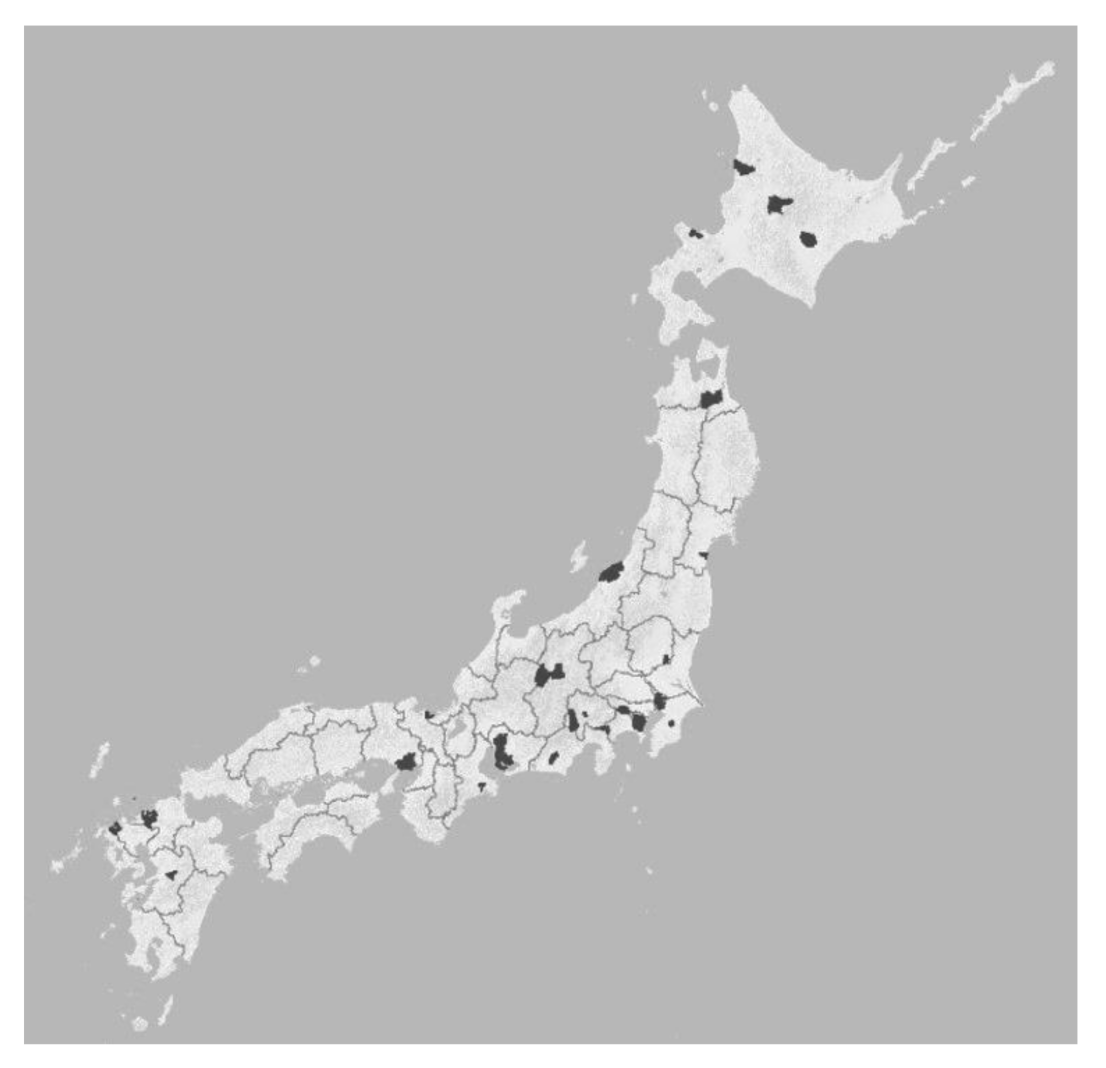
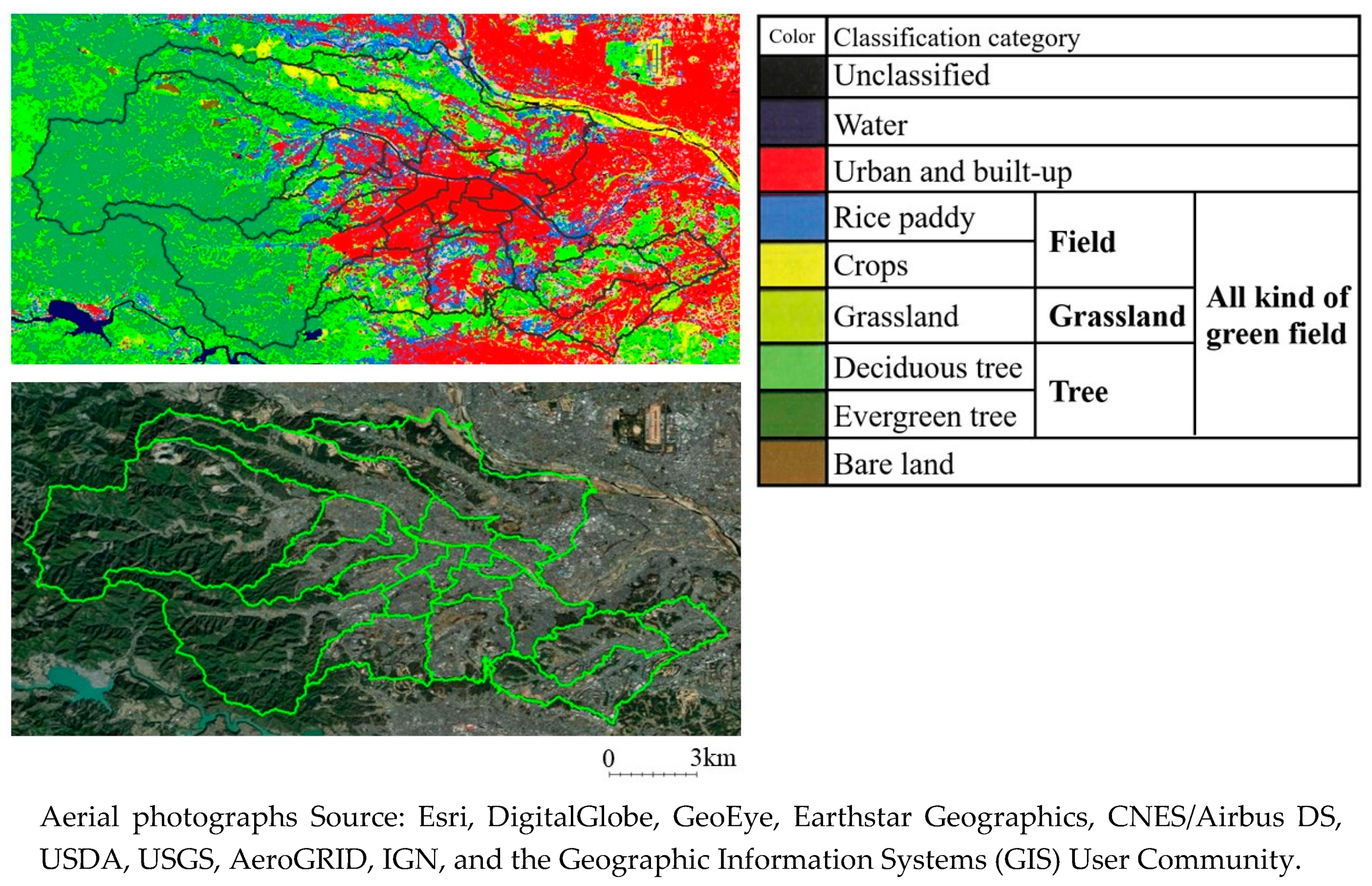
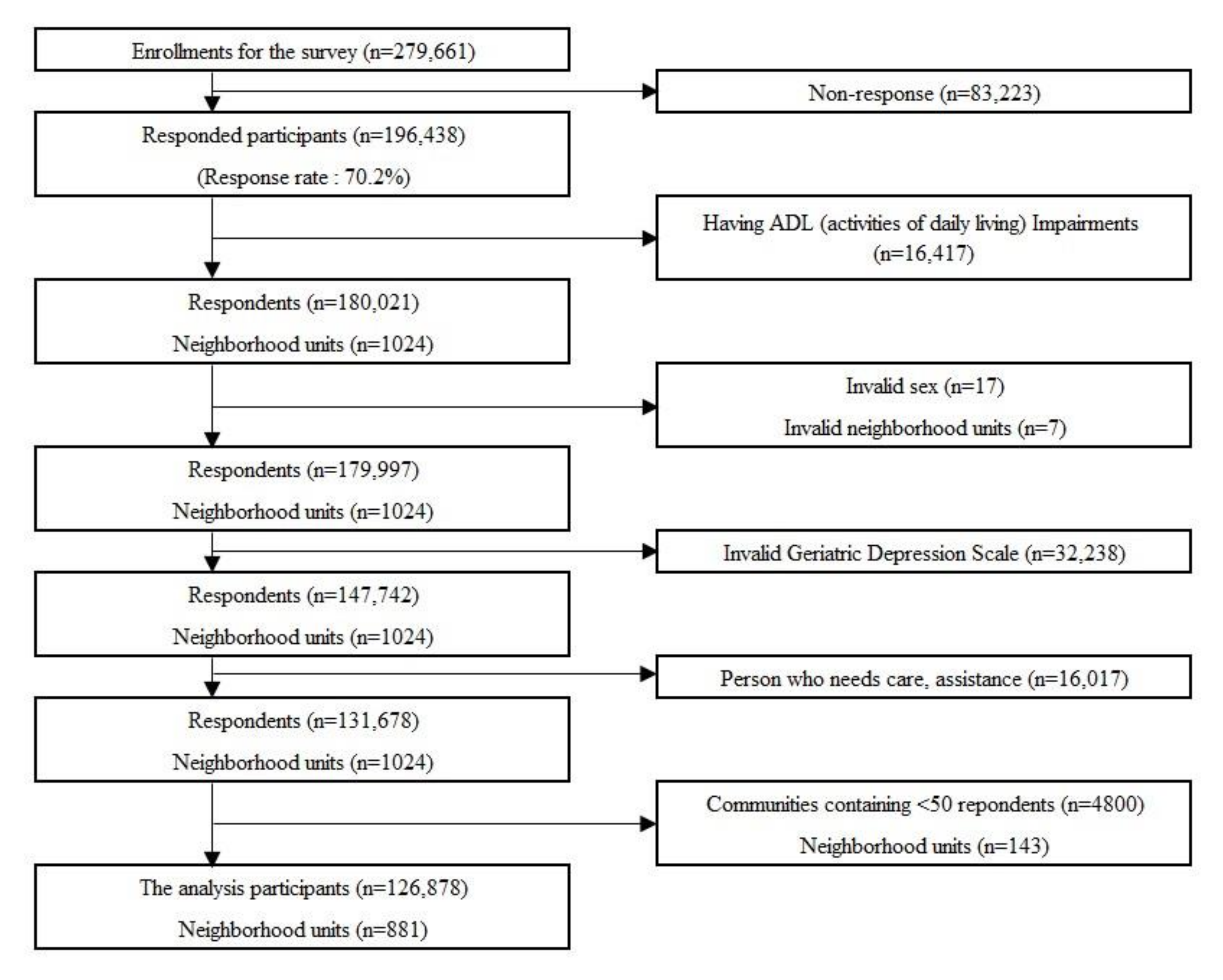
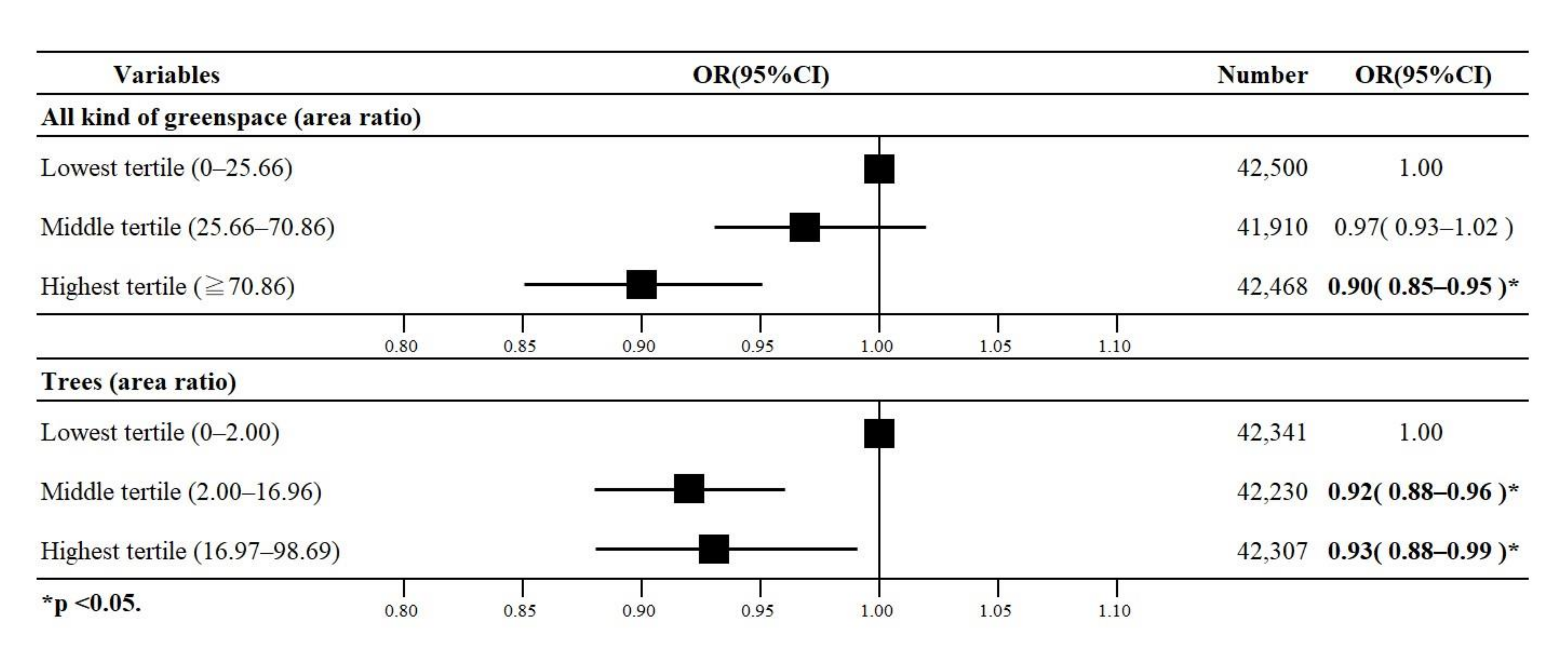
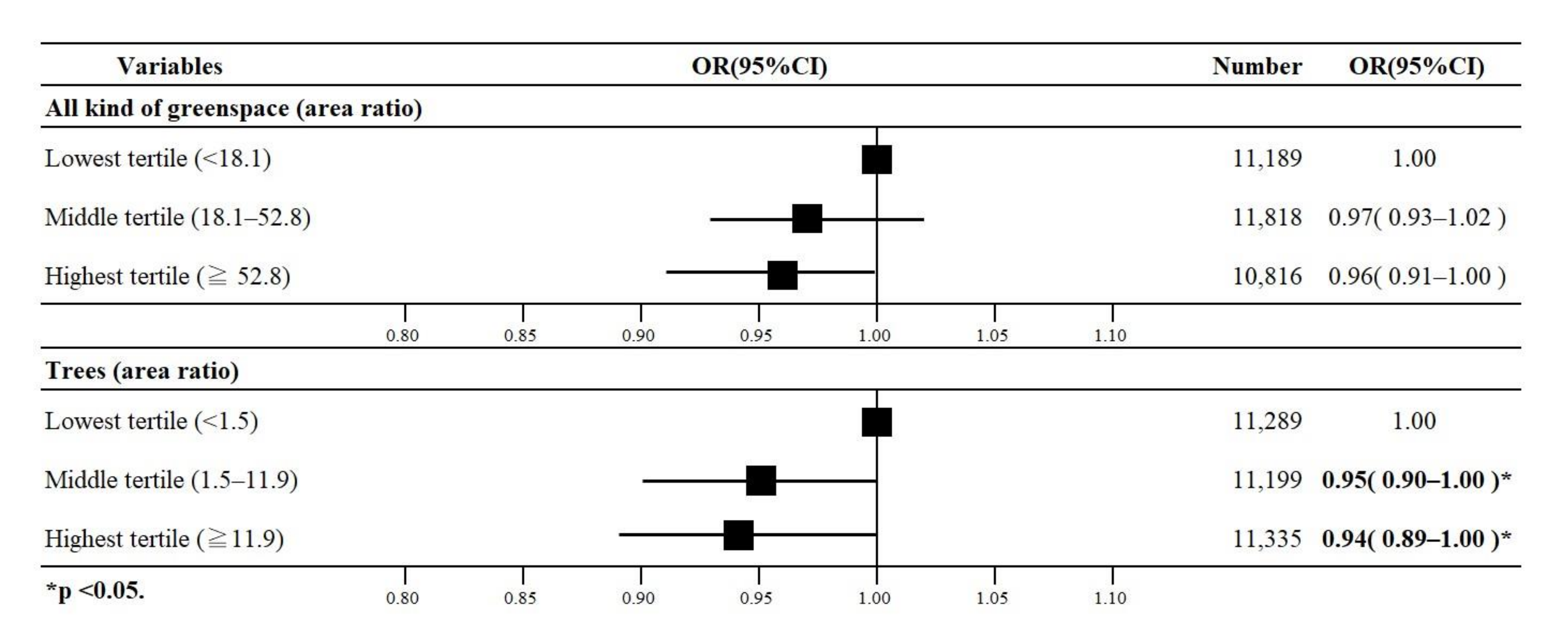
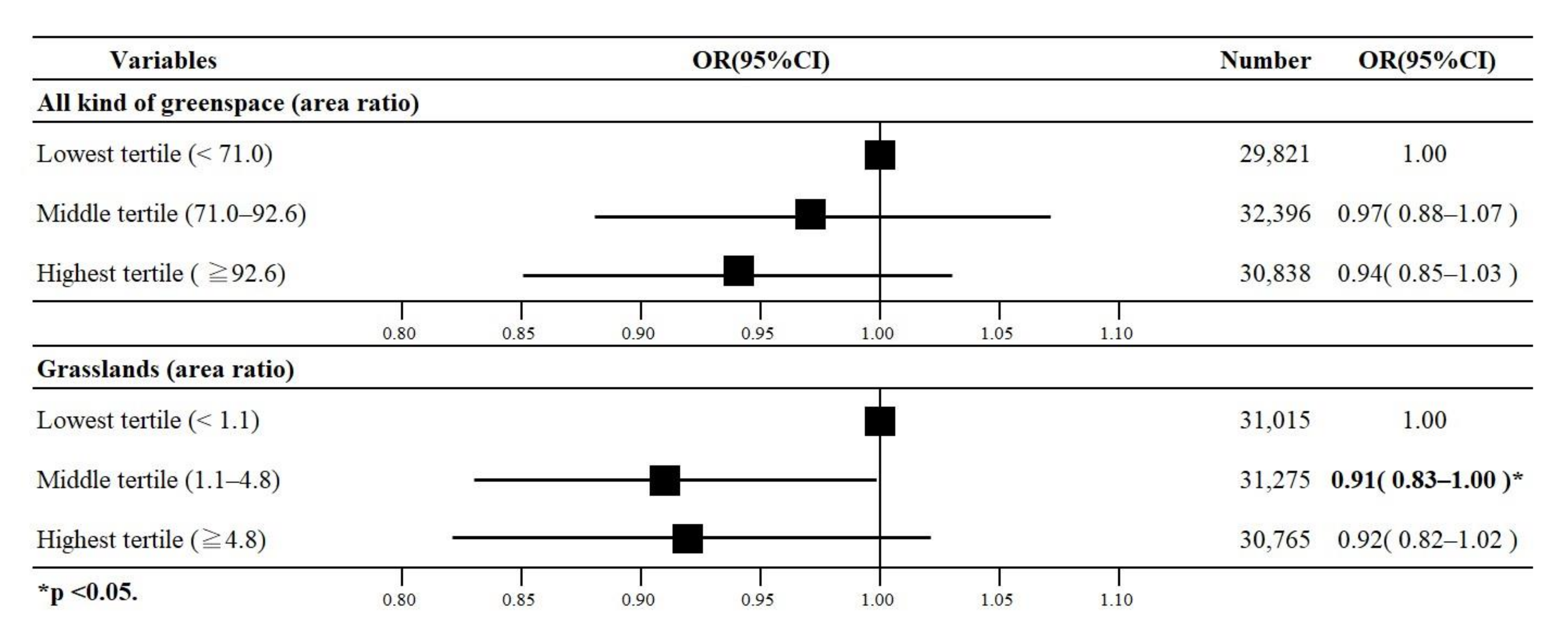
| Variables | Total (n = 126,878) | Depression (n = 25,846; 20.4%) | No Depression (n = 101,032; 79.6%) | |||
|---|---|---|---|---|---|---|
| Number | % | Number | % | Number | % | |
| Individual level variables | ||||||
| Sex | ||||||
| Men | 61,493 | 48.5 | 12,880 | 49.8 | 48,613 | 48.1 |
| Women | 65,385 | 51.5 | 12,966 | 50.2 | 52,419 | 51.9 |
| Age (years) | ||||||
| 65–69 | 42,150 | 33.2 | 8379 | 32.4 | 33,771 | 33.4 |
| 70–74 | 35,398 | 27.9 | 6880 | 26.6 | 28,518 | 28.2 |
| 75–79 | 27,928 | 22.0 | 5678 | 22.0 | 22,250 | 22.0 |
| 80–84 | 15,058 | 11.9 | 3377 | 13.1 | 11,681 | 11.6 |
| ≥85 | 6344 | 5.0 | 1532 | 5.9 | 4812 | 4.8 |
| Educational attainment (years) | ||||||
| <10 | 37,736 | 29.7 | 9469 | 36.6 | 28,267 | 28.0 |
| ≥10 | 87,866 | 69.3 | 16,056 | 62.1 | 71,810 | 71.1 |
| Missing | 1276 | 1.0 | 321 | 1.2 | 955 | 0.9 |
| Annual household income (Dollars) | ||||||
| <20,000 | 48,843 | 38.5 | 12,518 | 48.4 | 36,325 | 36.0 |
| 20,000–39,999 | 42,306 | 33.3 | 6502 | 25.2 | 35,804 | 35.4 |
| ≥40,000 | 12,174 | 9.6 | 1231 | 4.8 | 10,943 | 10.8 |
| Missing | 23,555 | 18.6 | 5595 | 21.6 | 17,960 | 17.8 |
| Living with others | ||||||
| No (living alone) | 17,802 | 14.0 | 5273 | 20.4 | 12,529 | 12.4 |
| Yes | 89,969 | 70.9 | 16,675 | 64.5 | 73,294 | 72.5 |
| Others/Missing | 19,107 | 15.1 | 3898 | 15.1 | 15,209 | 15.1 |
| Employment situation | ||||||
| Working | 33,158 | 26.1 | 5487 | 21.2 | 27,671 | 27.4 |
| Retired and not working now | 69,091 | 54.5 | 14,603 | 56.5 | 54,488 | 53.9 |
| Never had a job | 7590 | 6.0 | 1693 | 6.6 | 5897 | 5.8 |
| Missing | 17,039 | 13.4 | 4063 | 15.7 | 12,976 | 12.8 |
| Frequency of going outside (per week) | ||||||
| ≥4 times | 95,059 | 74.9 | 16,374 | 63.4 | 78,685 | 77.9 |
| <4 times | 30,715 | 24.2 | 9210 | 35.6 | 21,505 | 21.3 |
| Missing | 1104 | 0.9 | 262 | 1.0 | 842 | 0.8 |
| Drive a car | ||||||
| No | 52,358 | 41.3 | 12,421 | 48.1 | 39,937 | 39.5 |
| Yes | 74,520 | 58.7 | 13,425 | 51.9 | 61,095 | 60.5 |
| The longest type of occupation | ||||||
| Other than AG* | 102,857 | 81.1 | 20,489 | 79.3 | 82,368 | 81.5 |
| AG* | 4396 | 3.5 | 985 | 3.8 | 3411 | 3.4 |
| Never had a job | 7192 | 5.7 | 1647 | 6.4 | 5545 | 5.5 |
| Missing | 12,433 | 9.8 | 2725 | 10.5 | 9708 | 9.6 |
| Residence years | ||||||
| <10 years | 10,794 | 8.5 | 2987 | 11.6 | 7807 | 7.7 |
| ≥10 years | 114,637 | 90.4 | 22,452 | 86.9 | 92,185 | 91.2 |
| Missing | 1447 | 1.1 | 407 | 1.6 | 1040 | 1.0 |
| Neighborhood Measures | Mean | SD | Median | Min | Max | 1 | 2 | 3 | 4 |
|---|---|---|---|---|---|---|---|---|---|
| Total (n = 881) | |||||||||
| 1. All kinds of green field (area ratio) | 37.3 | 32.2 | 1.1 | 0.0 | 99.8 | 1.000 | |||
| 2. Trees (area ratio) | 15.5 | 22.7 | 0.8 | 0.0 | 98.7 | 0.781 ** | 1.000 | ||
| 3. Fields (area ratio) | 20.1 | 20.6 | 0.7 | 0.0 | 91.6 | 0.766 ** | 0.389 ** | 1.000 | |
| 4. Grasslands (area ratio) | 1.7 | 3.1 | 0.1 | 0.0 | 39.7 | 0.696 ** | 0.510 ** | 0.520 ** | 1.000 |
| 5. Residential population density (population/km2) | 9550.9 | 5166.6 | 174.1 | 795.8 | 37915.6 | −0.688 ** | −0.345 ** | −0.623 ** | −0.537 ** |
| Variables | Number | Model 1 | Model 2 | ||
|---|---|---|---|---|---|
| OR (95% CI) | OR (95% CI) | ||||
| All types of greenspaces (area ratio) | |||||
| Lowest tertile (0–25.66) | 42,500 | 1.00 | |||
| Middle tertile (25.66–70.86) | 41,910 | 0.97 | (0.93–1.02) | ||
| Highest tertile (≥70.86) | 42,468 | 0.90 | (0.85–0.95) * | ||
| Trees (area ratio) | |||||
| Lowest tertile (0–2.00) | 42,341 | 1.00 | |||
| Middle tertile (2.00–16.96) | 42,230 | 0.92 | (0.88–0.96) * | ||
| Highest tertile (16.97–98.69) | 42,307 | 0.93 | (0.88–0.99) * | ||
| Grasslands (area ratio) | |||||
| Lowest tertile (0–0.25) | 42,266 | 1.00 | |||
| Middle tertile (0.25–2.06) | 42,231 | 0.98 | (0.93–1.03) | ||
| Highest tertile (2.07–39.7) | 42,381 | 0.97 | (0.92–1.03) | ||
| Fields (area ratio) | |||||
| Lowest tertile (<13.38) | 42,340 | 1.00 | |||
| Middle tertile (13.38–36.11) | 42,494 | 1.01 | (0.96–1.06) | ||
| Highest tertile (≥36.12) | 42,044 | 1.01 | (0.95–1.07) | ||
| Residential population density (persons per kilometer squared) | |||||
| Lowest tertile (795.6–4508.5) | 42,256 | 1.00 | 1.00 | ||
| Middle tertile (4508.5–8957.5) | 42,286 | 0.94 | (0.89–1.00) * | 0.97 | (0.92–1.02) |
| Highest tertile (8957.5–37,915.6) | 42,336 | 0.89 | (0.84–0.95) * | 0.94 | (0.88–1.00) * |
| Variables | Urban (n = 93,055) | Rural (n = 33,823) | ||
|---|---|---|---|---|
| Model 1 | Model 2 | Model 1 | Model 2 | |
| OR (95% CI) | OR (95% CI) | OR (95% CI) | OR (95% CI) | |
| All types of greenspaces (area ratio) | ||||
| Lowest tertile | 1.00 | 1.00 | ||
| Middle tertile | 0.97 | 0.97 | ||
| (0.93–1.02) | (0.88–1.07) | |||
| Highest tertile | 0.96 | 0.94 | ||
| (0.91–1.00) | (0.85–1.03) | |||
| Trees (area ratio) | ||||
| Lowest tertile | 1.00 | 1.00 | ||
| Middle tertile | 0.95 | 0.93 | ||
| (0.90–1.00) * | (0.84–1.02) | |||
| Highest tertile | 0.94 | 1.00 | ||
| (0.89–1.00) * | (0.89–1.13) | |||
| Grasslands (area ratio) | ||||
| Lowest tertile | 1.00 | 1.00 | ||
| Middle tertile | 1.01 | 0.91 | ||
| (0.96–1.06) | (0.83–1.00) * | |||
| Highest tertile | 1.00 | 0.92 | ||
| (0.94–1.06) | (0.82–1.02) | |||
| Fields (area ratio) | ||||
| Lowest tertile | 1.00 | 1.00 | ||
| Middle tertile | 1.02 | 1.06 | ||
| (0.97–1.08) | (0.95–1.17) | |||
| Highest tertile | 1.03 | 1.14 | ||
| (0.96–1.09) | (1.01–1.28) | |||
Publisher’s Note: MDPI stays neutral with regard to jurisdictional claims in published maps and institutional affiliations. |
© 2020 by the authors. Licensee MDPI, Basel, Switzerland. This article is an open access article distributed under the terms and conditions of the Creative Commons Attribution (CC BY) license (http://creativecommons.org/licenses/by/4.0/).
Share and Cite
Nishigaki, M.; Hanazato, M.; Koga, C.; Kondo, K. What Types of Greenspaces Are Associated with Depression in Urban and Rural Older Adults? A Multilevel Cross-Sectional Study from JAGES. Int. J. Environ. Res. Public Health 2020, 17, 9276. https://doi.org/10.3390/ijerph17249276
Nishigaki M, Hanazato M, Koga C, Kondo K. What Types of Greenspaces Are Associated with Depression in Urban and Rural Older Adults? A Multilevel Cross-Sectional Study from JAGES. International Journal of Environmental Research and Public Health. 2020; 17(24):9276. https://doi.org/10.3390/ijerph17249276
Chicago/Turabian StyleNishigaki, Miho, Masamichi Hanazato, Chie Koga, and Katsunori Kondo. 2020. "What Types of Greenspaces Are Associated with Depression in Urban and Rural Older Adults? A Multilevel Cross-Sectional Study from JAGES" International Journal of Environmental Research and Public Health 17, no. 24: 9276. https://doi.org/10.3390/ijerph17249276
APA StyleNishigaki, M., Hanazato, M., Koga, C., & Kondo, K. (2020). What Types of Greenspaces Are Associated with Depression in Urban and Rural Older Adults? A Multilevel Cross-Sectional Study from JAGES. International Journal of Environmental Research and Public Health, 17(24), 9276. https://doi.org/10.3390/ijerph17249276







